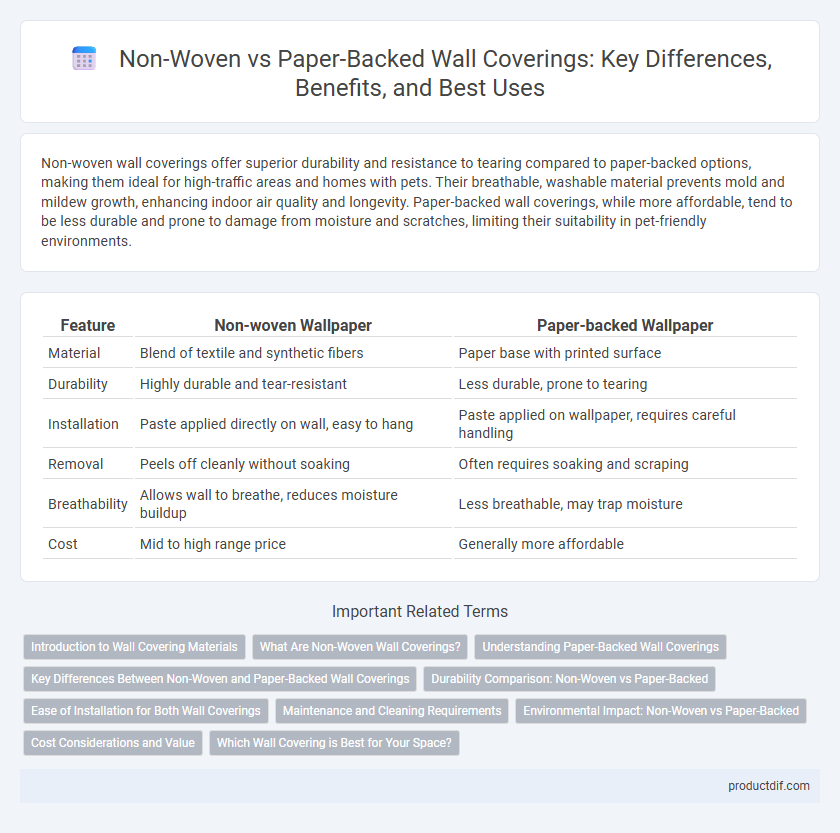Non-woven wall coverings offer superior durability and resistance to tearing compared to paper-backed options, making them ideal for high-traffic areas and homes with pets. Their breathable, washable material prevents mold and mildew growth, enhancing indoor air quality and longevity. Paper-backed wall coverings, while more affordable, tend to be less durable and prone to damage from moisture and scratches, limiting their suitability in pet-friendly environments.
Table of Comparison
| Feature | Non-woven Wallpaper | Paper-backed Wallpaper |
|---|---|---|
| Material | Blend of textile and synthetic fibers | Paper base with printed surface |
| Durability | Highly durable and tear-resistant | Less durable, prone to tearing |
| Installation | Paste applied directly on wall, easy to hang | Paste applied on wallpaper, requires careful handling |
| Removal | Peels off cleanly without soaking | Often requires soaking and scraping |
| Breathability | Allows wall to breathe, reduces moisture buildup | Less breathable, may trap moisture |
| Cost | Mid to high range price | Generally more affordable |
Introduction to Wall Covering Materials
Non-woven wall coverings are composed of synthetic fibers that offer durability, breathability, and easier installation compared to paper-backed options. Paper-backed wall coverings are made from cellulose fibers, providing a traditional texture but tend to be less durable and more prone to moisture damage. Choosing between non-woven and paper-backed materials depends on desired longevity, moisture resistance, and ease of upkeep for interior wall applications.
What Are Non-Woven Wall Coverings?
Non-woven wall coverings are made from a blend of natural and synthetic fibers, creating a durable, breathable material that resists tearing and stretching. These coverings are easy to install and remove, as they can be directly soaked with adhesive and applied to the wall without expansion issues common with paper-backed alternatives. Their moisture resistance and dimensional stability make non-woven wallpapers ideal for high-traffic areas and humid environments.
Understanding Paper-Backed Wall Coverings
Paper-backed wall coverings feature a paper base that offers breathability and ease of installation while providing a smooth surface for various designs. They are less durable compared to non-woven materials, which are made from synthetic fibers that resist tearing and moisture. Choosing paper-backed options suits low-traffic areas where cost-effectiveness and straightforward application are priorities.
Key Differences Between Non-Woven and Paper-Backed Wall Coverings
Non-woven wall coverings consist of a blend of natural and synthetic fibers, making them tear-resistant, breathable, and easy to install or remove without soaking. Paper-backed wall coverings are primarily made of cellulose fibers, which are less durable and prone to tearing during application or removal, requiring more care and preparation. Non-woven options provide superior dimensional stability and moisture resistance compared to paper-backed varieties, making them ideal for high-traffic or humid areas.
Durability Comparison: Non-Woven vs Paper-Backed
Non-woven wall coverings offer superior durability compared to paper-backed options, featuring enhanced resistance to tearing and moisture damage. Their fabric blend composition provides better dimensional stability, ensuring long-lasting adherence and fewer repairs over time. Paper-backed wall coverings, while budget-friendly, are more prone to peeling and damage from humidity, making them less suitable for high-traffic or damp areas.
Ease of Installation for Both Wall Coverings
Non-woven wall coverings offer superior ease of installation due to their lightweight, tear-resistant properties and the ability to apply adhesive directly to the wall, allowing for bubble-free and seamless application. Paper-backed wallpapers require pasting the backing, making them more prone to tearing, wrinkling, and alignment issues, which increases installation time and complexity. Professionals often prefer non-woven options for quick, efficient installations and enhanced durability during hanging.
Maintenance and Cleaning Requirements
Non-woven wall coverings offer superior durability and ease of maintenance compared to paper-backed options, resisting tears and allowing for gentle washing without damage. Paper-backed wallpapers are more susceptible to moisture and require delicate cleaning methods, often limited to dry brushing or light wiping to prevent weakening or peeling. Choosing non-woven materials ensures long-lasting appearance with minimal effort, ideal for high-traffic or humid environments.
Environmental Impact: Non-Woven vs Paper-Backed
Non-woven wall coverings often feature biodegradable fibers and lower levels of harmful chemicals, resulting in a reduced environmental footprint compared to traditional paper-backed options. Paper-backed wallpapers may contribute more to deforestation and waste due to their reliance on paper pulp and thicker adhesive layers. Choosing non-woven materials supports sustainable manufacturing practices and facilitates easier recycling and disposal, minimizing long-term environmental impact.
Cost Considerations and Value
Non-woven wall coverings typically offer higher durability and ease of installation, which can reduce labor costs and provide long-term value despite a higher initial price compared to paper-backed options. Paper-backed wall coverings remain more budget-friendly upfront but may require frequent replacements or repairs, increasing overall expenses over time. Evaluating total cost of ownership and project lifespan is essential when choosing between non-woven and paper-backed wall coverings for cost efficiency and value.
Which Wall Covering is Best for Your Space?
Non-woven wall coverings offer superior durability and moisture resistance, making them ideal for high-traffic or humid areas like kitchens and bathrooms. Paper-backed options provide a budget-friendly choice with a variety of designs but lack the same level of tear resistance and ease of installation. Selecting the best wall covering depends on your space's durability needs and maintenance preferences, with non-woven being preferable for long-lasting performance.
Non-woven vs Paper-backed Infographic

 productdif.com
productdif.com